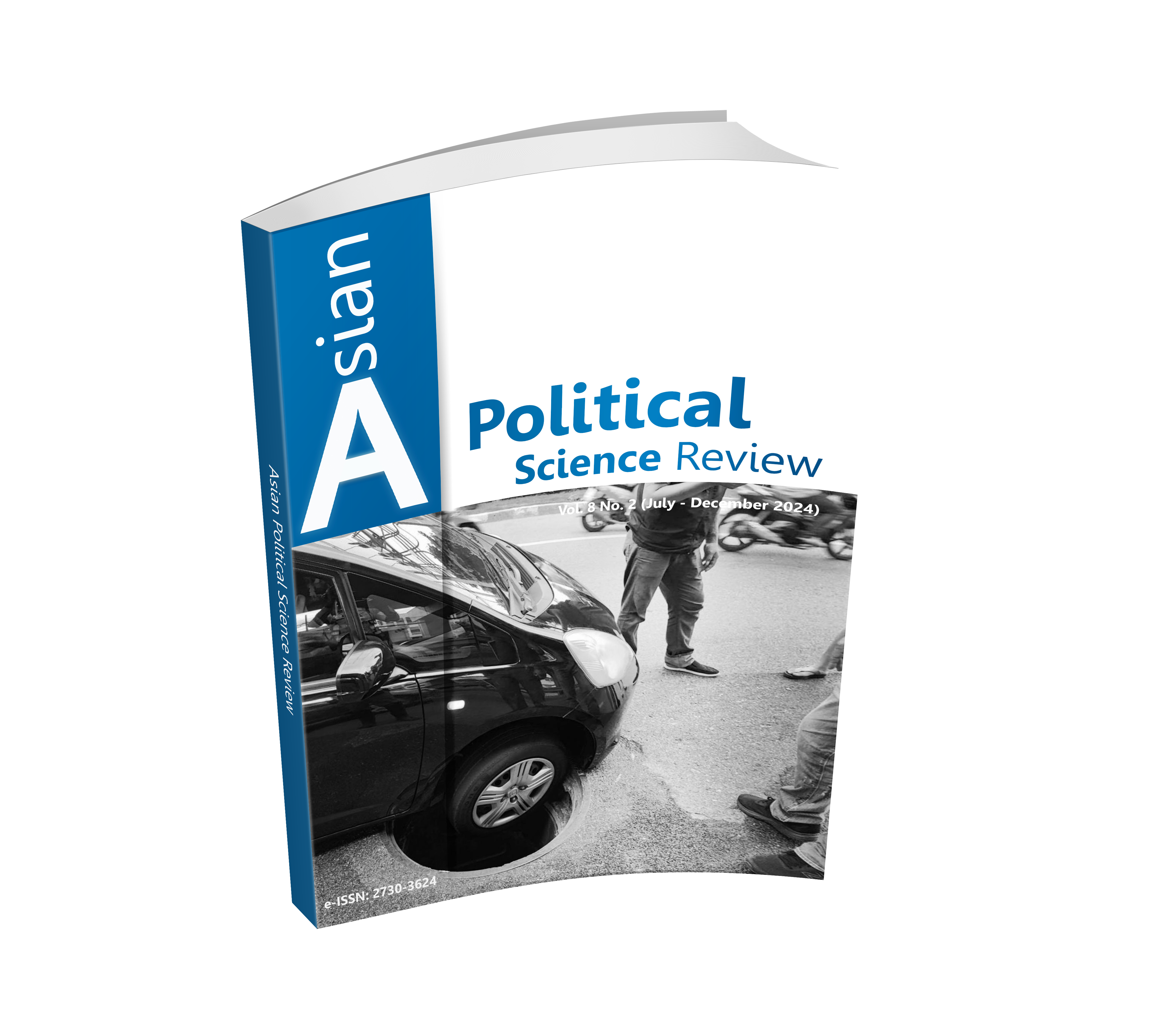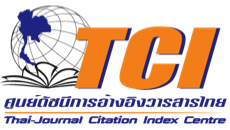DETERMINANTS OF INTENTION TO ADOPT E-GOVERNMENT: MEDIATING EFFECT OF TRUST IN E-GOVERNMENT
DOI:
https://doi.org/10.14456/apsr.2024.15Keywords:
e-Government, Trust, Technology, Perceived Usefulness, Intention to AdoptAbstract
In the present economy, adoption of e-Government is one of the important concepts to deliver facts about government to the public by using online tools, websites, social media, etc. The aim of study is to examine the influence of trust in government (TIG), trust in technology (TIT), and perceived usefulness (PU) on the intention to adopt e-Government (IAEG). The present study also identified the intervening effect of trusts in e-Government (TIEG) and how they mediate the IAEG. The data is collected through an administrated survey questionnaire that is free from any type of ambiguities. The questionnaire is collected from 200 administrative citizens’ students by convenient sampling technique. This study used the Smart PLS software for analyzing the relationship variables. The findings of the study reveal that TIG, TIT, PU, and TIEG have a significant and positive relationship with IAEG.
Downloads
References
Akkaya, C., Obermeier, M., Wolf, P., & Krcmar, H. (2011). Components of trust influencing egovernment adoption in Germany. A paper presented at the International Conference on Electronic Government, Delft, The Netherlands.
AlAwadhi, S. (2019). A Proposed Model of Trust Factors for E-Government Adoption and Civic Engagement. A paper presented at the 52nd Hawaii International Conference on System Sciences, Hawaii, USA.
Barber, B. (1983). The logic and limits of trust. New Jersey: Rutgers University Press.
Bélanger, F., & Carter, L. (2008). Trust and risk in e-Government adoption. The Journal of Strategic Information Systems, 17(2), 165-176.
Butler Jr, J. (1991). Toward understanding and measuring conditions of trust: Evolution of a conditions of trust inventory. Journal of Management, 17(3), 643-663.
Carter, L., & Bélanger, F. (2005). The utilization of e‐government services: citizen trust, innovation and acceptance factors. Information Systems Journal, 15(1), 5-25.
Codagnone, C., & Wimmer, M. (2007). Roadmapping eGovernment: Research Visions and Measures towards Innovative Governments in 2020. Rheinland-Pfalz: University of Koblenz-Landau.
Colesca, S. (2009). Understanding trust in e-Government. Engineering Economics, 63(4), 7-15.
Ebrahim, Z., & Irani, Z. (2005). E-Government adoption: architecture and barriers. Business Process Management Journal, 11(5), 589-611.
Gilbert, D., Balestrini, P., & Littleboy, D. (2004). Barriers and benefits in the adoption of e-Government. International Journal of Public Sector Management, 17(4), 286-301.
Horst, M., Kuttschreuter, M., & Gutteling, J. (2007). Perceived usefulness, personal experiences, risk perception and trust as determinants of adoption of e-Government services in The Netherlands. Computers in Human Behavior, 23(4), 1838-1852.
Hung, S., Chang, C., & Yu, T. (2006). Determinants of user acceptance of the e-Government services: The case of online tax filing and payment system. Government Information Quarterly, 23(1), 97-122.
Hwang, M., Li, C., Shen, J., & Chu, Y. (2004). Challenges in e-Government and security of information. Information & Security, 15(1), 9-20.
Jacob, D., Fudzee, M., Salamat, M., & Herawan, T. (2019). A review of the generic end-user adoption of e-Government services. International Review of Administrative Sciences, 85(4), 799-818.
Janowski, T. (2015). Digital government evolution: From transformation to contextualization. Government Information Quarterly, 32(3), 221-236.
Kalu, K., & Remkus, B. (2010). The evolution of social capital and civic engagement between nonprofit networks and county representatives: A social constructivist approach. Social Science Computer Review, 28(1), 135-150.
Karniawati, N., Redjo, S., Suwaryo, U., & Mulyawan, R. (2017). e-Government in Public Service: Studies on Tangibles Aspects in Licensing Services at Penanaman Modal dan Pelayanan Terpadu Satu Pintu Office, West Java, Indonesia. Asian Political Science Review, 1(1), 56-64.
Kotrlik, J., & Higgins, C. (2001). Organizational research: Determining appropriate sample size in survey research appropriate sample size in survey research. Information Technology, Learning, and Performance Journal, 19(1), 43-50.
Krejcie, R., & Morgan, D. (1970). Determining sample size for research activities. Educational and Psychological Measurement, 30(3), 607-610.
Kumar, V., Mukerji, B., Butt, I., & Persaud, A. (2007). Factors for successful e-Government adoption: A conceptual framework. Electronic Journal of E-Government, 5(1), 63-76.
Kurfalı, M., Arifoğlu, A., Tokdemir, G., & Paçin, Y. (2017). Adoption of e-Government services in Turkey. Computers in Human Behavior, 66, 168-178.
Luhmann, N. (1979). Trust and Power. NewYork: John A. Wiley and Sons.
Oke, A., Ogunsami, D., & Ogunlana, S. (2012). Establishing a common ground for the use of structural equation modelling for construction related research studies. Construction Economics and Building, 12(3), 89-94.
Papadopoulou, P., Nikolaidou, M., & Martakos, D. (2010). What is trust in e-Government? A proposed typology. A paper presented at the 43rd Hawaii International Conference on System Sciences, Hawaii, USA.
Park, R. (2008). Measuring factors that influence the success of E-Government initiatives. A paper presented at the 41st Annual Hawaii International Conference on System Sciences, Hawaii, USA.
Patel, H., & Jacobson, D. (2008). Factors Influencing Citizen Adoption of E-Government: A Review and Critical Assessment. A paper presented at the 16th European Conference on Information Systems, Galway, Ireland.
Pavlou, P. (2003). Consumer acceptance of electronic commerce: Integrating trust and risk with the technology acceptance model. International Journal of Electronic Commerce, 7(3), 101-134.
Sabani, A., Deng, H., & Thai, V. (2019). Evaluating the Development of E-Government in Indonesia. A paper presented at the 2nd International Conference on Software Engineering and Information Management, Bali, Indonesia.
Saengchai, S., Sriyakul, T., & Jermsittiparsert, K. (2020). The Impact of Citizen Trust, Citizen Disposition and Favourable Social Characteristics on the Adoption of e-Government: Mediating Roles of Perceived Behavioural Control. International Journal of Innovation, Creativity and Change, 12(11), 375-393.
Shajari, M., & Ismail, Z. (2012). Trustworthiness: A key factor for adoption models of e-Government services in developing countries. A paper presented at the International Conference on Education and Management Innovation, Singapore.
Sriyakul, T., & Jermsittiparsert, K. (2020). Role of E-Government and Open Data to Enhance Transparency in ASEAN Region: A Panel Data Analysis. Journal of Security and Sustainability Issues, 10(Oct), 337-347.
Susanto, T. (2013). Individual acceptance of e-Government: a literature review. A paper presented at the 2nd International Conference on Informatics Engineering & Information Science, Kuala Lumpur, Malaysia.
Tan, C., Benbasat, I., & Cenfetelli, R. (2008). Building citizen trust towards e-Government services: do high quality websites matter?. A paper presented at the 41st Annual Hawaii International Conference on System Sciences, Hawaii, USA.
Voutinioti, A. (2013). Determinants of user adoption of e-Government services in Greece and the role of citizen service centres. Procedia Technology, 8, 238-244.
Wang, Y., & Emurian, H. (2005). An overview of online trust: Concepts, elements, and implications. Computers in Human Behavior, 21(1), 105-125.
Warkentin, M., Gefen, D., Pavlou, P., & Rose, G. (2002). Encouraging citizen adoption of e-Government by building trust. Electronic Markets, 12(3), 157-162.
Welch, E., Hinnant, C., & Moon, M. (2004). Linking citizen satisfaction with e-Government and trust in government. Journal of Public Administration Research and Theory, 15(3), 371-391.
Yonazi, J., Sol, H., & Boonstra, A. (2010). Exploring issues underlying citizen adoption of e-Government initiatives in developing countries: The case of Tanzania. A paper presented at the 10th European Conference on e-Government: National Center for Taxation Studies University of Limerick, University of Limerick, Ireland.

Downloads
Published
How to Cite
Issue
Section
License
Copyright (c) 2024 Authors

This work is licensed under a Creative Commons Attribution-NonCommercial-NoDerivatives 4.0 International License.











.png)


